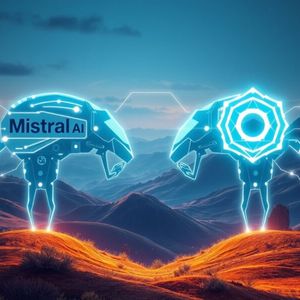
BitcoinWorld Mistral AI’s Remarkable Ascent: A Formidable OpenAI Competitor In the rapidly evolving world of artificial intelligence, where innovation often dictates market shifts and investment opportunities, a new challenger has emerged that could reshape the landscape for crypto and tech enthusiasts alike. While many eyes are on the established giants, Mistral AI , a French powerhouse, is rapidly making its mark as a significant OpenAI competitor , attracting billions in funding and challenging the status quo with its commitment to open-source principles. Understanding its trajectory is crucial for anyone tracking the future of decentralized AI, Web3 infrastructure, and the broader tech market. Understanding Mistral AI: Europe’s Answer to OpenAI? Mistral AI , founded in 2023, has quickly positioned itself as one of Europe’s most promising tech startups. Hailing from France, the company develops the popular AI chatbot, Le Chat, and a suite of foundational large language models. French President Emmanuel Macron himself has championed Mistral, urging citizens to use Le Chat over competitors like ChatGPT. This endorsement underscores the company’s national significance and its ambition to lead in the global AI race. In a significant leap, Mistral AI’s valuation soared to €11.7 billion (approximately $13.8 billion) following a Series C funding round. This impressive growth highlights its potential to genuinely rival industry leaders, making it a formidable OpenAI competitor on the world stage. The Expanding Universe of Mistral AI Models and Products Mistral AI is not just a single product; it’s an ecosystem of advanced AI models and tools designed for various applications. The company’s slogan, “put frontier AI in the hands of everyone,” signals a commitment to accessibility, contrasting with the more closed-source approach of some rivals. Its flagship AI chatbot , Le Chat, available on iOS and Android, quickly garnered over a million downloads. Recent updates in July 2025 enhanced Le Chat with a “deep research” mode, native multilingual reasoning, advanced image editing, and “Projects” for organized chat spaces. As of September 2025, Le Chat also features “Memories” for remembering past conversations. Beyond Le Chat, Mistral AI offers a diverse portfolio of models: Mistral Large 2: The primary large language model, succeeding Mistral Large. Pixtral Large: A new addition to the multimodal Pixtral family, unveiled in 2024. Magistral: Mistral’s first family of reasoning models, launched in June 2025. Mistral Medium 3: Released in May 2025, optimized for efficiency in coding and STEM tasks. Voxtral: The company’s first open-source AI audio model, released in July 2025. Devstral: An AI model designed for coding, openly available under the Apache 2.0 license for commercial use. Devstral Medium and an upgraded Devstral Small were released in July 2025. Codestral: An earlier generative AI model for code, though its license restricted commercial applications. Les Ministraux: A family of models optimized for edge devices like phones. Mistral Saba: Focused on Arabic language processing. Additionally, Mistral AI introduced Mistral OCR in March 2025 for PDF-to-text conversion and Mistral Code in June 2025, a vibe coding client competing with established tools. The Visionaries Behind Mistral AI The leadership team at Mistral AI brings a wealth of experience from top-tier AI research labs. CEO Arthur Mensch previously worked at Google’s DeepMind, while CTO Timothée Lacroix and Chief Scientist Officer Guillaume Lample are former Meta staffers. These founders share a common background in AI research at major U.S. tech companies with significant presences in Paris, pooling their expertise to build a leading European AI firm. Co-founding advisers include Jean-Charles Samuelian-Werve and Charles Gorintin from health insurance startup Alan. Former digital minister Cédric O also advises the company, a role that has generated some public discussion due to his prior government position. Powering Growth: Mistral AI’s Impressive Funding Journey Mistral AI’s rapid ascent is underscored by its remarkable AI funding rounds. Since its inception in 2023, the company has raised approximately €1 billion in total, including debt financing. The journey began with a record-breaking $112 million seed round in June 2023, just one month after its founding, valuing the startup at $260 million. This was followed by a €385 million Series A round ($415 million) six months later, pushing its valuation to a reported $2 billion. A Series A extension included Microsoft’s $16.3 million convertible investment in February 2024 as part of a strategic partnership. June 2024 saw Mistral secure another €600 million (about $640 million) in equity and debt, led by General Catalyst, at a $6 billion valuation. This round attracted significant investors such as Cisco, IBM, Nvidia, and Samsung Venture Investment Corporation. The most recent and substantial round, a €1.7 billion (about $2 billion) Series C, closed on September 9, 2025, led by Dutch semiconductor giant ASML. This round propelled Mistral AI’s valuation to an astonishing €11.7 billion (approximately $13.8 billion), with continued support from existing backers like DST Global, Andreessen Horowitz, Bpifrance, General Catalyst, Index Ventures, Lightspeed, and NVIDIA. This substantial capital influx positions Mistral AI strongly as an OpenAI competitor with the resources to drive significant innovation. Strategic Partnerships and Enterprise Solutions Mistral AI has forged crucial alliances to expand its reach and capabilities. A 2024 deal with Microsoft included a €15 million investment and a strategic partnership for distributing Mistral’s AI models via Microsoft’s Azure platform. Other key partnerships include: Agence France-Presse (AFP): Allowing Le Chat to query AFP’s text archive (January 2025). France’s army and job agency, Luxembourg, shipping giant CMA, German defense tech startup Helsing, IBM, Orange, and Stellantis. Joint venture for an AI Campus in Paris with UAE-investment firm MGX, NVIDIA, and Bpifrance (May 2025). Launch of Mistral Compute, a European AI platform powered by Nvidia processors, in 2026 (June 2025). AI for Citizens initiative, aimed at transforming public services through AI (July 2025). Partnership with ASML to explore AI model use across ASML’s product portfolio (September 2025). On the enterprise front, Mistral AI introduced the Mistral Agents API in May 2025 to empower businesses with practical AI applications. September 2025 saw the unveiling of a revamped Connectors directory, integrating Le Chat with over 20 enterprise tools like Asana, Atlassian, Box, Google Drive, Notion, and Zapier, with Databricks and Snowflake integrations on the horizon. These integrations are vital for the adoption of Mistral’s AI chatbot in professional environments. Open Source or Closed Source? Mistral AI’s Approach A key differentiator for Mistral AI , particularly in its role as an OpenAI competitor , is its nuanced approach to open source. While its premier AI models are proprietary with weights not commercially available, Mistral also champions free models, providing weights under the Apache 2.0 license. An example is Mistral NeMo, a research model open-sourced in collaboration with Nvidia in July 2024. This hybrid strategy allows Mistral to offer cutting-edge proprietary solutions while contributing to the open-source community, aligning with its mission to democratize AI. How Does Mistral AI Generate Revenue? While many of Mistral AI’s offerings have free tiers, the company has a clear monetization strategy. Its AI chatbot , Le Chat, introduced a Pro subscription in February 2025 for $14.99 a month. For businesses, Mistral AI monetizes its premier AI models through APIs with usage-based pricing. Enterprises can also license these models directly. Furthermore, strategic partnerships, many highlighted at the Paris AI Summit, likely contribute a significant share of its revenue. Reportedly, Mistral AI’s revenue is already in the eight-digit range, signaling a strong commercial foundation. Navigating the Regulatory Landscape and Future Outlook Mistral AI is also actively involved in the discourse around AI regulation. CEO Arthur Mensch was among European CEOs who signed an open letter in July 2025, advocating for a two-year delay before key obligations of the EU Artificial Intelligence Act come into force. Despite this, the European Commission remains committed to its original timeline. Regarding its future, Mensch firmly stated in January 2025 that Mistral is “not for sale” and an IPO is “the plan.” Given the substantial AI funding it has secured and its soaring valuation, an IPO makes strategic sense, offering a pathway for investors to realize returns while maintaining the company’s independence. To truly solidify its position and ward off acquisition rumors, scaling revenue to justify its impressive valuation will be a critical next step. The journey of this European AI giant is one to watch closely. Mistral AI has rapidly ascended to become a central figure in the global AI landscape, establishing itself as a compelling OpenAI competitor . With a diverse array of advanced AI models , a user-friendly AI chatbot in Le Chat, and a staggering amount of AI funding , the French startup is not just building technology; it’s shaping the future of artificial intelligence with a distinct European vision. Its strategic partnerships, hybrid open-source approach, and clear path to monetization underscore its potential for sustained growth and impact. As it continues to innovate and expand, Mistral AI stands as a testament to European ambition and a crucial player in the ongoing AI revolution. To learn more about the latest AI market trends, explore our article on key developments shaping AI models’ features and institutional adoption. This post Mistral AI’s Remarkable Ascent: A Formidable OpenAI Competitor first appeared on BitcoinWorld and is written by Editorial Team
